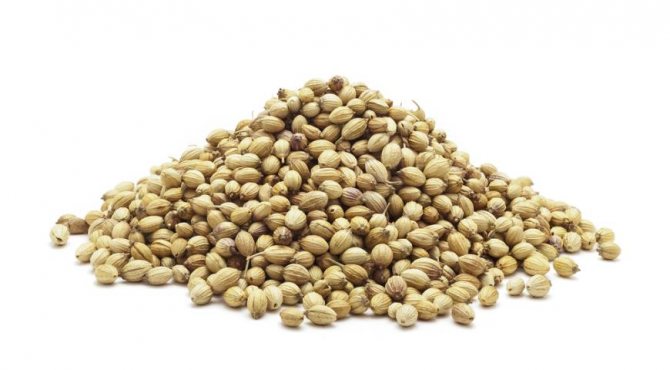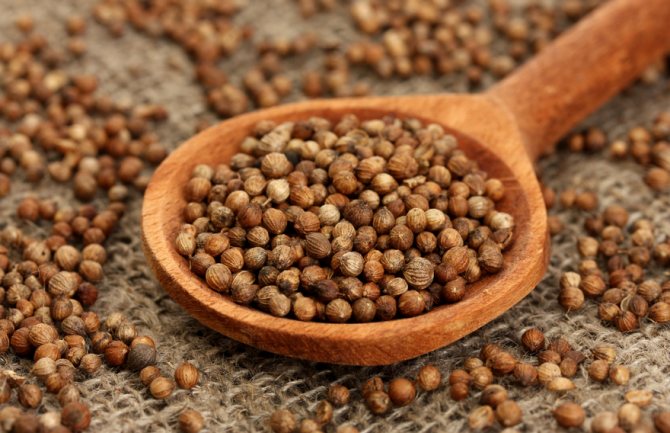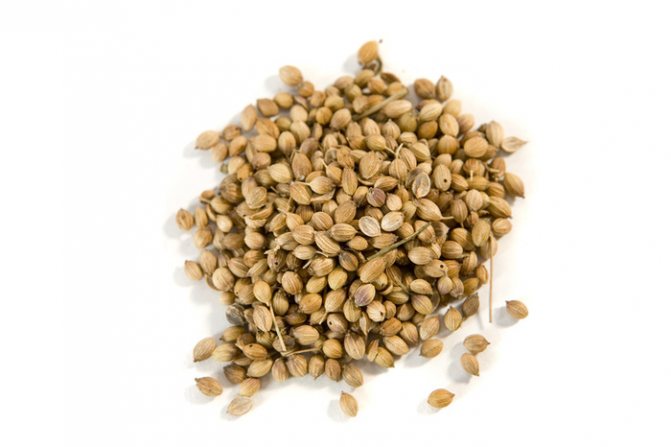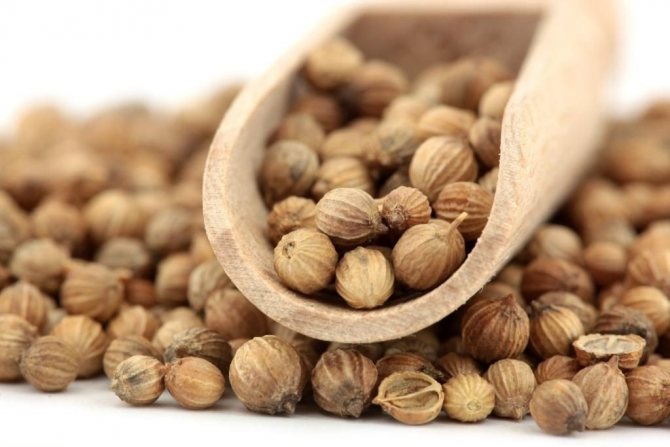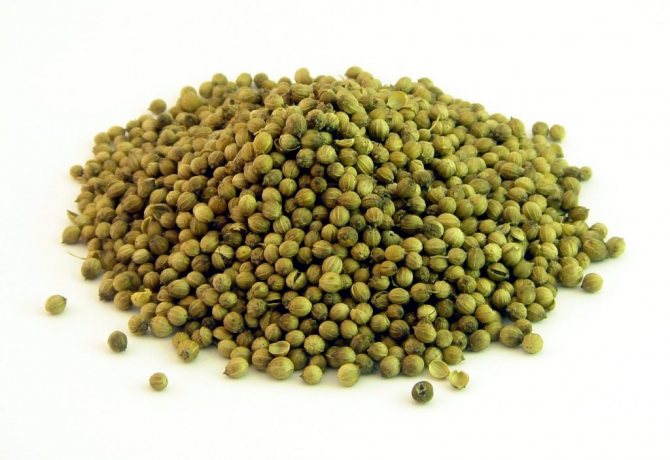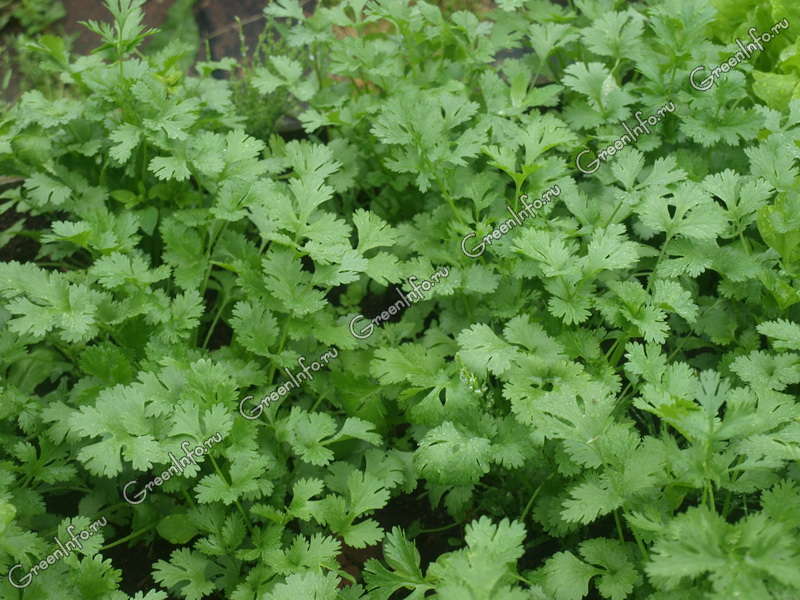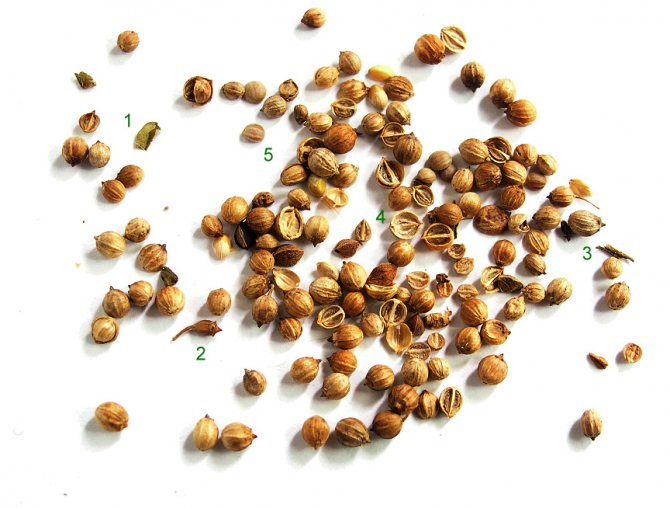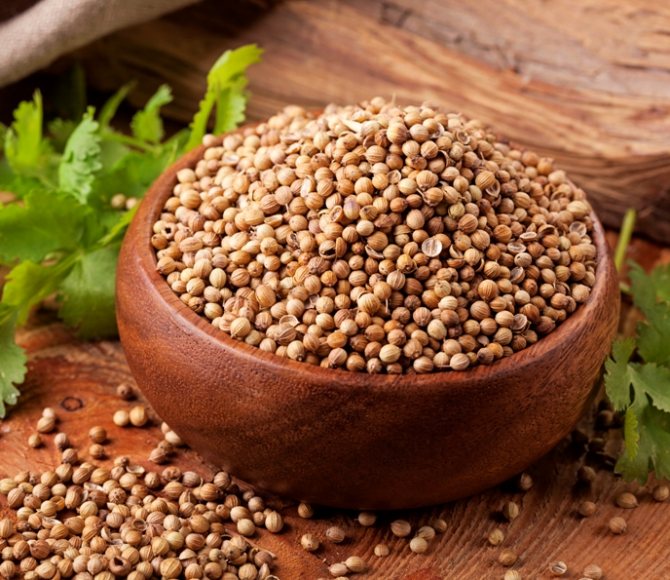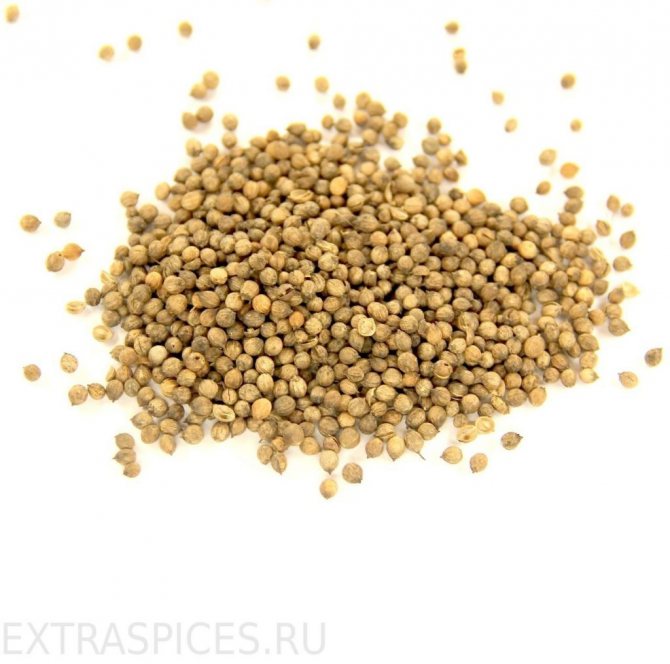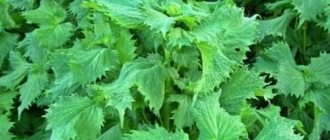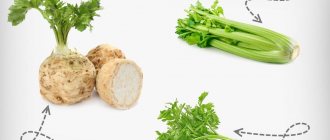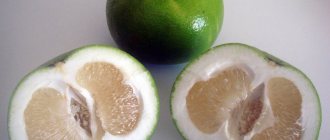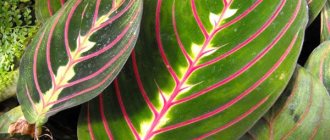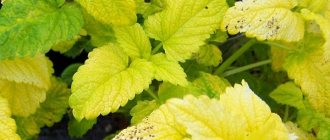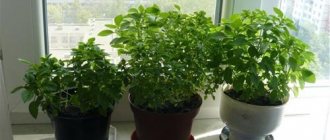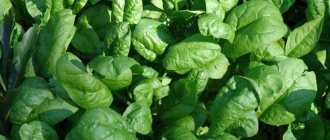
Origin and distribution.
The homeland of coriander is the Mediterranean, where it was cultivated for a thousand years BC, so as you can see this plant has a long history. In Ancient Hellas, Ancient Rome, Palestine, Babylon and India, it has long been known as a vegetable, spice, essential oil and medicinal plant.
It has been cultivated since ancient times in some countries of Europe and America.
In our country, it is widely distributed as an essential oil culture.
RARE PLANT SEEDS FOR YOUR GARDEN - FREE SHIPPING. PRICES ARE VERY LOW. THERE ARE REVIEWS


In the Non-Black Earth Region, it is grown a little, although in amateur gardens it grows well and gives a lot of greenery.
What is coriander and cilantro
Different parts of this plant differ in smell and in the way they are used. This herb is a relative of dill, cumin, fennel and anise. Its other name is Chinese parsley. Cilantro is the greenery of a plant, and coriander is its seeds.
Traditional Georgian and Indian cuisine is not complete without this spice. In addition, the plant is widely used in medicine. It has antiseptic, immunostimulating and other properties useful for the human body. Coriander seeds are used to make wound healing ointments.
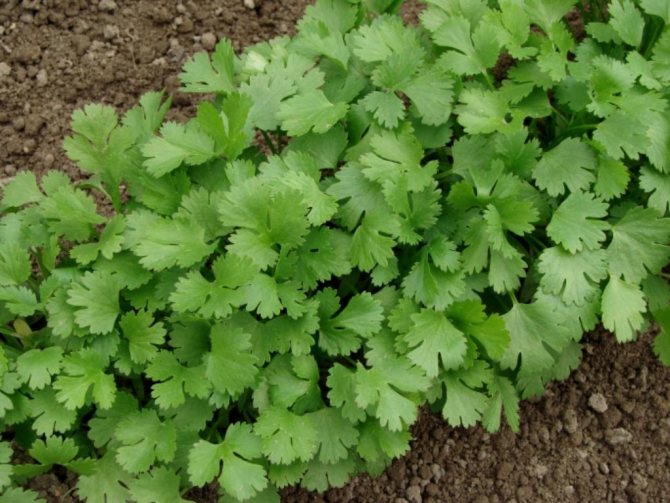

Photo of cilantro - its appearance resembles parsley
What does coriander look like? Botanical description
It is an annual plant of the Umbelliferae family with a pungent scent reminiscent of a crushed bug. For this reason, some people do not eat these greens.
What coriander looks like: the stems of the plant reach a height of 70 cm. Shoots are erect, divided at the top. Coriander greens are widely used in salads. Some people do not know what cilantro looks like, so they confuse it with parsley, since the shape of the leaves is almost the same. Umbrella inflorescences are formed on the plant, consisting of small white or pink flowers. The fruit is a hard, ribbed, round seed.
Basal leaves are wide enough and are on long petioles. The lower leaves at the stem are pinnately divided, and the upper leaves are pinnately dissected. Coriander root is fusiform. In length, it reaches 30-40 cm.


Photo of blooming cilantro
The use of coriander in everyday life: recipes for housewives in a notebook
Vitamin drink made from coriander (cilantro).
Pour coriander seeds with boiling water, cover and stand at a low boil for 20-30 minutes, then leave for 10-15 minutes, drain. Add sugar and cook for 2-3 minutes. After cooling, pour in any juice.
For 1 liter of drink - 20 g of coriander seeds, 800 ml of water, 120 g of sugar and 200 g of juice.
Choleretic, pain reliever: pour 1 teaspoon of seeds with a glass of boiling water, wait until it cools down and filter through cheesecloth. Take a third of a glass 2-3 times a day.
Digestive disorders, flu-like condition. Infusion: 10-30 g of crushed fruit per 1 liter of water. Insist for 10 minutes. Take 1 cup after each meal.
Coriander alcohol tincture: forty drops in one glass of water, taken three times a day.
By the way: coriander stalks spread out in the house scare away rodents well.(you can read about other plants that repel rats and mice in this article)
I wish you success in growing this wonderful and useful plant.
ORDER QUALITY AND CHEAP SEEDS AND OTHER PRODUCTS FOR HOME AND COTTAGE. PRICES ARE BOTTLE. CHECKED! JUST LOOK FOR YOURSELF AND BE AMAZED HOW WE HAVE REVIEWS. GO >>>
Below are other entries on the topic "Cottage and garden - do it yourself"
- Cilantro growing for seeds and herbs (cilantro). Harvesting and collecting seeds. How to grow coriander for greens ...
- Coriander cultivation and benefits: The coriander plant - benefits and ...
- Cilantro-coriander: varieties and cultivation: Cultivation of cilantro - planting and ...
- Seed hardening - how is it right ?: How to harden seeds before sowing Cucumbers, ...
- A simple and easy way of harvesting seeds for the next year: Simple to the point of disgrace but effective ...
- Making your own cabbage seeds is a great way !: HOW TO PREPARE YOUR CABBAGE SEEDS ...
- Soaking seeds in different solutions - good advice: Soak seeds in ... vodka, soda ...
Subscribe to updates in our groups and share.
How to grow cilantro for herbs and seeds
Cilantro is propagated using seeds. Sowing material can be purchased at the store or collected by yourself. Scattered ripe cilantro seeds hibernate under the snow and germinate when it gets warm.
Coriander seed is a crop of long daylight hours. The less sunlight a plant receives, the slower it grows.
Planting and leaving
The climate in areas where cilantro grows should be warm and sunny. It grows mainly in the southern regions of Russia, but it is grown throughout the country. The plant is frost-hardy, so sowing can be done in autumn. In this case, the greens will appear in March. Most often, coriander seeds are sown in open soil in the spring, and are harvested by the end of summer.
The landing site must be chosen on the sunny side of the site. It is desirable that the bed is on a hill - this will save the seeds from getting wet. The soil is suitable sandy loam or loamy with neutral acidity. In addition, it should be loose and well fertilized.
Sowing is carried out randomly or in furrows at the rate of 2 g per 1 m². The planting depth is 1.5 cm. The distance between shoots should be at least 10 cm, and between rows - 25-35 cm. Greens appear 2-4 weeks after planting. Caring for the plant is quite unpretentious: weeding, loosening the soil and timely watering.
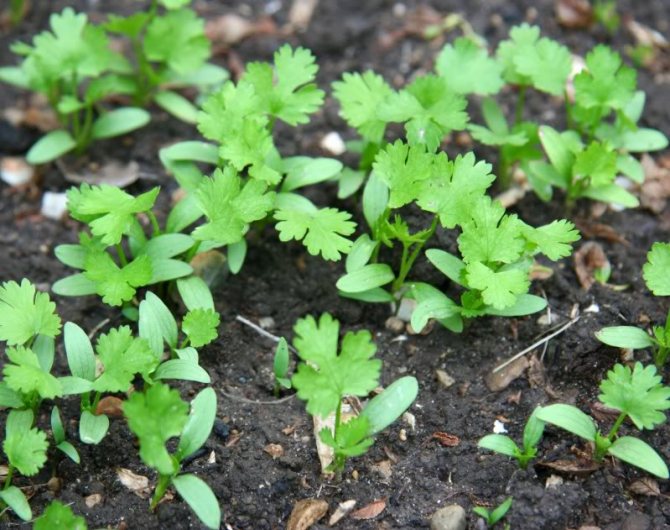

Photo of fresh sprouts of cilantro
Breeding methods for coriander
Melissa - planting and care outdoors
This plant is propagated by seed. Sowing material can be harvested by hand or purchased from a specialized outlet. Also, this grass is characterized by self-sowing reproduction, in which the seeds that have been under the snow cover during the winter are able to sprout on their own with the onset of spring - this will eliminate the need to plant this plant every year.
Self-collection of seed
The first step is to determine the degree of seed maturity.


Coriander bloom
A correct agronomic analysis can be carried out based on the external condition of the fruits:
- Ripe seeds have turned brown and can be easily removed by hand. You can collect them when the process of shedding has begun;
- The ability to germinate seed material retains no more than two years, if you do not sow them immediately.
Seed preparation before sowing
To make the rate of seed germination and their ripening even faster, before growing spicy cilantro, they should be soaked in a solution with the addition of a growth stimulant before planting begins.
Helpful information. Aloe juice is considered a folk remedy for accelerating the growth of cilantro.
Sowing time for coriander seeds
You can sow cilantro both at the beginning and at the end of the horticultural season:
- Spring-summer sowing in open ground conditions is carried out at the end of April. The appearance of peduncles on a plant sown in the period when the calendar summer is just beginning, or at the end of May, occurs after 20 days.
Helpful information. A slowdown in the development of cilantro planting occurs with a decrease in the duration of daylight hours.
The minimum ejection of the arrowhead occurs in the period from July to early autumn - at this time, the greenery develops with particular intensity. Harvesting will be possible only if the condition of timely removal of peduncles at an early stage of development of this part of the plant is met.
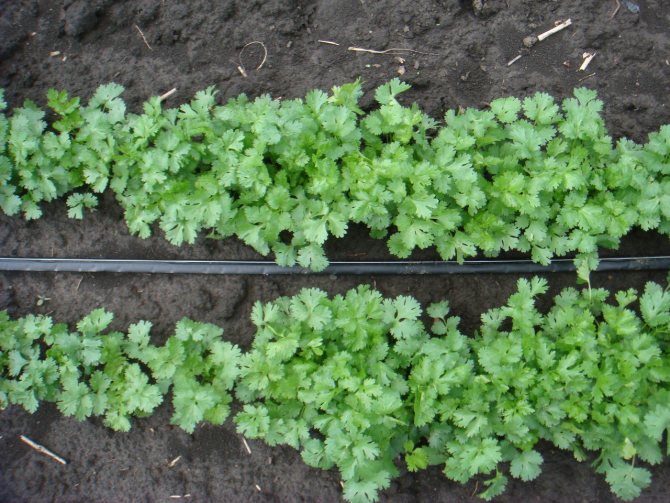

Coriander in the garden
- Autumn sowing is carried out by the end of October if further warming is impossible. In this case, early seed germination will occur in the next season when the first warming occurs.
Advice. In order to start harvesting the correct seed in June, it is preferable to plant cilantro in open ground with seeds in the spring as early as possible.
Algorithm for sowing a cilantro plant growing from seeds in open ground conditions:
- For a planting area of 1 m2, prepare about 3 grams of seed;
- Plant the seeds at a 2-centimeter depth;
- Thin out the sprouted shoots several times.
Note. The distance observed when planting plants in the garden on an open ridge is 13 centimeters. Row spacings should be approximately 20 cm apart.
The first shoots appear a month after starting to grow cilantro, however, certain weather conditions can contribute to an earlier germination of cilantro.
A regular herbal harvest is possible when sowing every two weeks during the warm season. You can cut the spicy grass 45 days after sowing. Several crop lots can be grown within the same plot.
Note! Re-sowing requires adding nitroammofosk or superphosphate to 1 m2 of soil in the amount of 1 teaspoon.
In addition, cilantro can be sown at home on a windowsill, where it is capable of producing almost the same bountiful harvests as in the garden:
- Prepare a container for planting, the ideal option for which would be a seedling box or container;
- Prepare soil material that you can mix yourself from organic components or purchase ready-made land on a trading platform that sells products for gardeners and gardeners;
- Purchase or collect seeds in advance;
- Sow seed material;
- Constantly maintain a stable level of room temperature in the room;
- Provide the necessary soil moisture;
- Extend daylight hours by using a fluorescent lamp.
Advice. If possible, it is recommended to install a phytolamp instead of a fluorescent lamp.
When to harvest cilantro and coriander
Fresh cilantro can be used to prepare meals as soon as the greens appear. The coriander seeds will be ready to harvest in late summer when they turn brown. In the southern regions, the fruits ripen in July, in the central and northern regions - at the end of August or in September.
The grains are small, so you won't be able to collect them by hand. The plant must be cut at the root, tied in bunches and hung in a room protected from the wind. The optimal solution is the attic. A film is spread below, onto which the grains will crumble.
After 2 weeks, the bundles need to be shaken so that the remaining grains fall out. The harvest remains only to sift.
Conditions for growing cilantro
The plant prefers loose light fertile soil with a slightly acidic reaction. It develops poorly on clayey and heavy soil, which forms a dense crust. In order for the plant to grow and develop normally, about 4 kg of compost or humus must be added to the garden bed.In the process of growth and development, the plant is not fed.
The cilantro bed must be dug to a depth of 20 cm, leveled, watered, and after a few hours you can start sowing. The optimal sowing time is the second half of April. With this sowing time, the plant will bloom in July, and the seeds will ripen by the end of summer. Sowing cilantro is best done in shaded areas. For a garden with an area of 10 sq. m. 20-25 grams of seeds are consumed. Coriander emerges about 3 weeks after sowing.
When to buy and how to choose cilantro and coriander
Coriander is cilantro, but in seed form. The green part of the plant (leaves) is sold from June to early September. If grown in a greenhouse, it can be purchased throughout the year.
Smell and taste of coriander
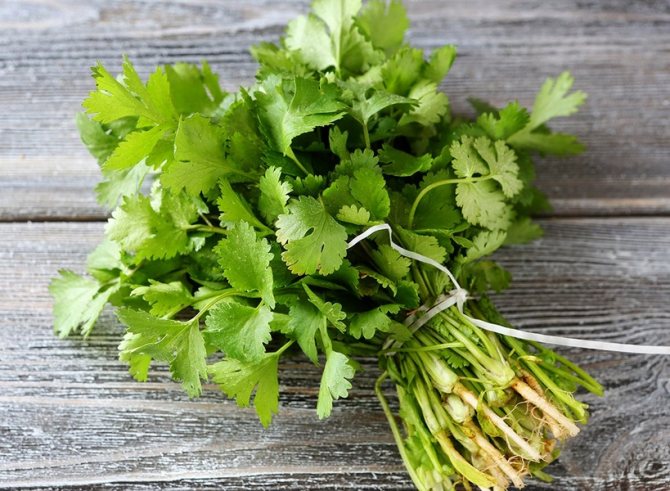

Fresh greens of cilantro will enrich the diet with components useful for the body.
When choosing, you need to pay attention to the appearance: the leaves must be fresh and strong. Dull greens with yellow streaks should not be taken. The leaves taste bitter, have a pungent odor.
The seeds have a sweet taste and aroma similar to woody ones. Thanks to their spicy scent, they are used as an additive to meat dishes, pasta and soups.
Harvesting


Cilantro pruning is carried out on those plants that have reached a height of 10 cm. Young plants are used for cooking. Over time, old, coarse parts of the plant acquire a bitter taste, which can negatively affect the taste of the dish. Pruning is carried out in small quantities. So, you cannot cut off more than a third of the foliage, as this can lead to the death of the plant. If pruning is done correctly, cilantro can still yield over several cycles.
Cultivation of coriander for seeds is carried out using the same technology. The difference lies in the collection of seeds. The collection takes place in the second half of August. The seeds are thoroughly dried in the sun, peeled and packed in paper bags. If the seeds have a brown hue and a pleasant spicy aroma, then they are grown correctly.
Storage rules and harvesting coriander for the winter
Rules for the preparation and storage of coriander seeds: Collecting should be done at the end of August. Unripe grains will have an unpleasant odor even after drying.
- You need to choose dry weather, rip off the umbrellas and leave them to dry in a ventilated place where the sun's rays do not fall.
- Rub the umbrellas in your hands to separate the seeds.
- Pour the grains into a glass jar or canvas bag.
- Shelf life - no more than 4 years in a cool dry place.
There are several ways to harvest greens.
Natural
- Do not dry in direct sunlight, as most of the nutrients will be lost. Drying steps:
- wash the greens;
- put it on paper towels so that all the water is absorbed into them;
- when the leaves are dry, they need to be cut;
- place the chopped herb in a storage container;
- dried cilantro should be stored in a dry, dark place (for example, on a balcony).
In the oven
- leaves need to be washed, dried and cut;
- preheat the oven to + 40 ... + 45 ° С (at a higher temperature, useful properties are lost);
- distribute the chopped leaves on a baking sheet and place in the oven for 4-5 hours;
- the dried grass should be green, crumble in the hands, but not turn into dust.
- Storage conditions are the same as in 1 case. Subject to these rules, greens can be used not only in winter, but throughout the year.
Umbrella family
Coriander, or cilantro, is an annual plant.
Coriander was grown in ancient Egypt, and was known to the ancient Greeks. In ancient times it was cultivated in Central Asia and Transcaucasia. Currently distributed in China, India and countries adjacent to the Mediterranean and Black Seas.
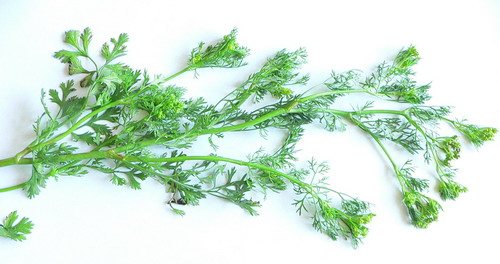

Coriander seed Cilantro - Soriandrum sativum L.
Other ways to prepare seasoning
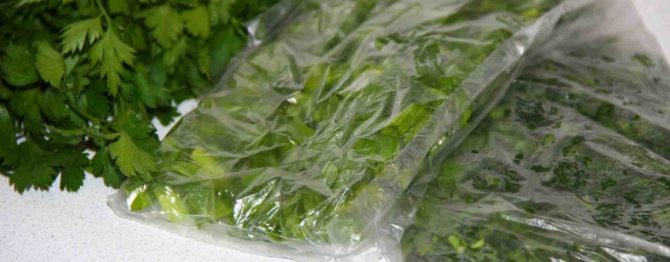

You can freeze cilantro greens in plastic bags or containers.
Freezing in vegetable oil
- cut the greens into pieces of 3 cm long;
- pour it into a blender;
- add vegetable oil at the rate of 80 ml. for 50 g of greenery;
- stir until puree;
- put the mixture in ice molds (you do not need to fill it to the top, since the volume will increase during freezing);
- put the forms in the freezer for several hours;
- Pour frozen cubes into a bag and store in the freezer.
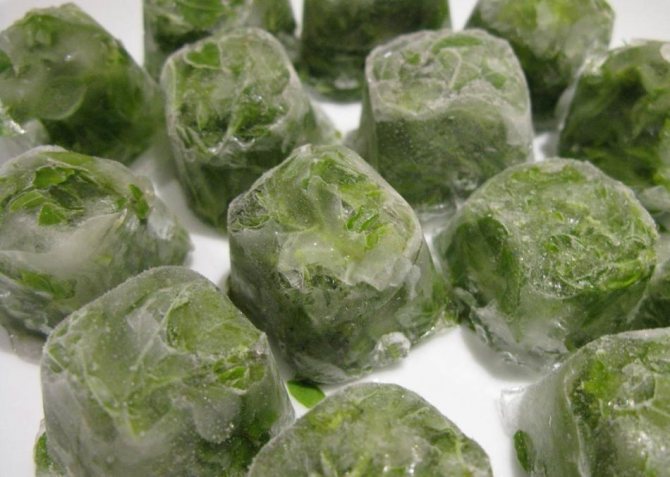

Freezing in ice cube trays is an easy and convenient way to store cilantro
Frozen in butter
- chop greens and pour into an empty bowl;
- add melted butter at the rate of 100 g per 3 tbsp. l. cilantro;
- mix, add salt, pepper, garlic and lime zest to taste;
- stir again and put the mixture on a sheet of parchment;
- leave in the refrigerator to harden;
- transfer to a bag and store in the freezer.
Salting
- wash and dry greens;
- take salt (250 g per 1 kg of herbs);
- put greens in jars, sprinkling with salt;
- press down the contents of the jar to form juice;
- cover the containers with lids and put them in the refrigerator;
- every other day, you can add more greens, since the contents will settle;
- shelf life is 10 months.
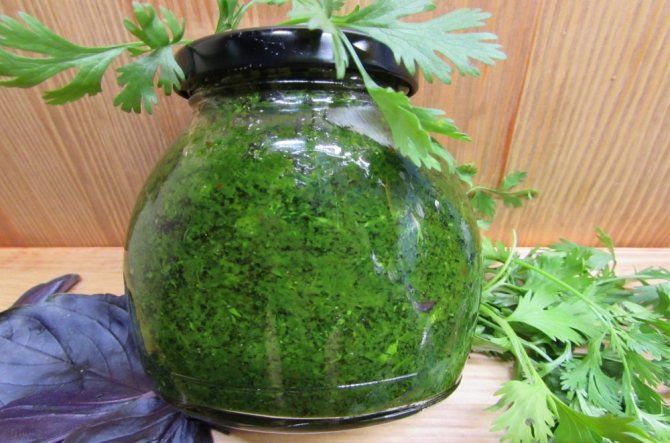

Canning the cilantro will allow you to enjoy the flavor of the plant until the next harvest.
Pickling
- greens need to be washed, dried, cut and put into jars;
- pour marinade and let it brew;
- you can pour vegetable oil on top to increase storage time.
For the marinade you will need:
- water (0.3 l);
- vinegar 9% (1 tbsp. l.);
- salt (1 pinch).
Salting is considered the best options for harvesting cilantro, since in this case the maximum amount of nutrients is preserved.
Prescriptions for various diseases
Flatulence
Add 1-2 drops of coriander essential oil to 1 tablespoon of honey. Eat after meals. Repeat after 6-7 hours.
Heavy menstruation
Juice the coriander herb. Take it in 2-5 ml for each kilogram of weight. Coagulability increases in 1 - 1.5 hours after ingestion and lasts 5-6 hours.
Decreased potency and frigidity
Pour 2 teaspoons of coriander seeds in 1 glass of water, stir well. Drink this solution daily until complete recovery.
Angina, chronic tonsillitis
Pour 1 teaspoon of chopped coriander greens with 1 cup boiling water, leave for 20 minutes, drain. Gargle with warm infusion.
Wounds
Grind dry coriander leaves into powder. Sprinkle them over the wound.
Valuable qualities of coriander and cilantro
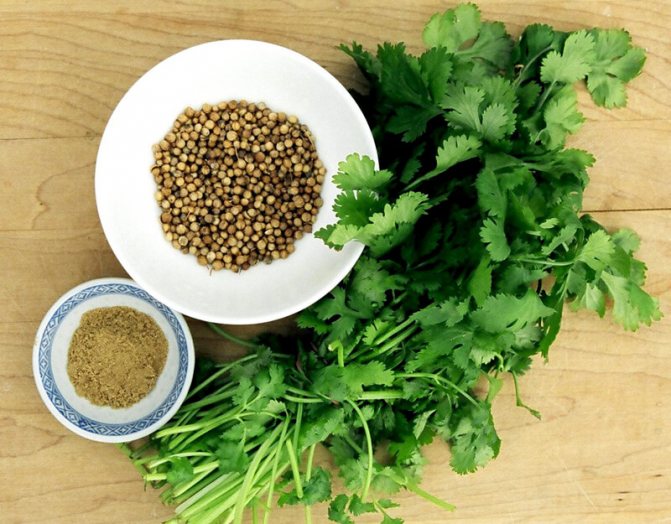

All parts of the plant are rich in substances useful to humans.
The properties of cilantro are widely used in medicine, since the plant contains many substances necessary for the body.
Leaves and seeds are used for the preparation of infusions and decoctions used in traditional medicine.
The healing properties of coriander help in the treatment of certain disorders, these are:
- heart disease;
- pulmonary pathology;
- stomach diseases;
- ophthalmic pathology;
- diseases of the skin.
Chemical composition and calorie content of coriander
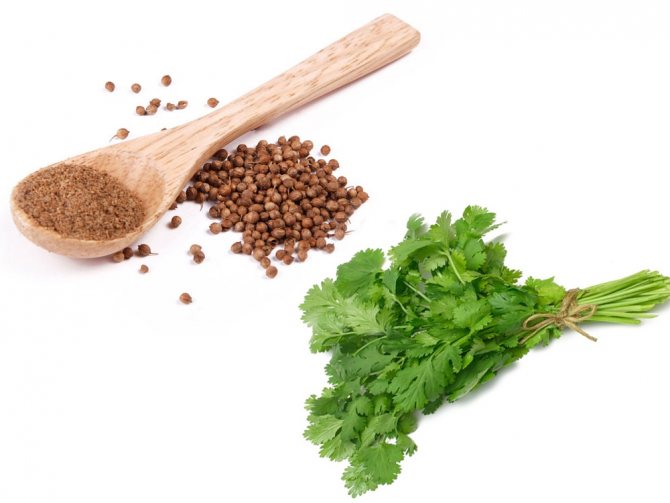

Both greens and plant seeds are valuable raw materials.
The plant contains the following substances:
- Essential oils. They are contained in large quantities and are the main medicinal component of the plant.
- Tannins and alkaloids. Have a positive effect on the human body.
- Vitamins (A, E, PP, K, B) and trace elements. Concentrated in stems and leaves.
- Minerals (iodine, sodium, phosphorus, calcium). The work of the heart muscle is impossible without potassium, which is present in large quantities in greens.
- Pectins, starch, dietary fiber and protein. Necessary for the normal functioning of all body systems.
100 g of the product contains only 23 kcal, so coriander can be used as a seasoning even during a diet.
General information
Cilantro is grown everywhere. This herb is used freshly harvested and dried as a complement to a huge range of dishes and sauces, making the culinary product spicy in taste. Due to the high content of essential oils, cilantro greens have a very strong aroma characteristic of spices. The seeds are also widely used in the culinary field.
Note. Coriander has good resistance to the cold temperatures that are typical for mid-latitude winters.
The Japanese people, who have been improving the process of planting cilantro for more than 5 thousand years, claim that the use of coriander has a positive effect on life expectancy. The spread of Korean national dishes made this herbaceous plant famous in our country.
The chemical composition of cilantro includes the following mineral elements:
- essential oils;
- potassium;
- calcium;
- phosphorus;
- iodine;
- vitamin A;
- vitamin E;
- vitamin K;
- vitamin B;
- vitamin P;
- vitamin PP.


Coriander
Fresh cilantro helps to increase appetite and accelerate the breakdown processes for heavy foods.
Ailments for which the leaf and seed parts of the plant are especially useful:
- decreased brain activity;
- deterioration of the heart;
- a tendency to hysteria;
- oppressed states.
There are a huge number of varietal varieties of coriander. Their difference lies in the specific purpose of growing a plant: for obtaining a seed yield, one variety is presented, and for collecting greenery - completely different from the first category, aimed at obtaining seeds. All of them, like other horticultural crops, are subdivided into varieties of early ripening, mid-ripening and late ripening periods.
Who shouldn't eat coriander
Despite its medicinal properties, not everyone benefits from cilantro. Before eating it, you need to familiarize yourself with the contraindications. Use this ingredient with caution in the following pathologies:
- thrombophlebitis;
- coronary artery disease;
- arterial hypertension.
Side effects when used
In some cases, coriander (seasoning) can cause side effects:
- There is a sharp decrease in glucose in the body.
- Allergic reactions on the skin may appear.
- The development of photosensitization (hypersensitivity of the body) is possible.
- Food poisoning can occur if you abuse ground coriander.
It is not recommended to consume cilantro and seeds during pregnancy and lactation.
Cilantro (coriander): photo
Butter


Coriander oil has a wide range of medicinal properties
The oil of this plant is used in medicine and cosmetology. It has a healing and resorbing effect during treatment:
- runny nose;
- sore throats;
- purulent wounds;
- bites;
- fungal infections;
- nosebleeds.
Antihelminthic and diuretic effects are combined with the ability to normalize metabolic processes in the body. In chronic respiratory diseases, it dissolves and removes phlegm. Coriander oil can help normalize insulin levels in the body. It stimulates the production of estrogen, reduces nervous tension and has a complex effect on anorexia.
Coriander oil is a potent antibacterial agent. It disinfects, warms and numbes the affected area.
In addition, ether is able to awaken appetite and fight food poisoning. It is used to normalize digestive processes.
Ether has a strong effect, therefore it is used in cosmetology in minimal doses. It is a regenerating agent capable of completely renewing the skin's texture.Even one procedure is enough to reduce the oiliness of the skin.
How to prepare the soil for growing coriander
Before planting Chinese parsley seeds in the ground, you need to choose a location. Coriander grows well on sandy loam and loamy soils with low acidity. Experts believe that the best option for sowing will be the places where perennial plants used to grow. Here you just need to remove all the grass and dig up the area. The soil is mixed with a small amount of cut grass.
Since coriander takes root ideally on light soils, when preparing the site, coarse sand can be added to the ground. The heavier the soil, the more sand you need. Soil fertility also plays an important role here. To get a good harvest of fragrant grass, top dressing is regularly applied to the ground.
Coriander is a light-loving plant. Therefore, it is preferable to cultivate it in areas where the shadow of trees falls. The technology for growing coriander has many nuances. Compliance with all points will allow you to grow a full harvest.
What is dried coriander used for?
There are fewer uses for dried coriander than for fresh coriander. This spice not only improves the aroma of the dish, but also benefits the body in the following conditions:
- diseases of the stomach;
- menstrual disorders;
- conjunctivitis;
- mouth ulcers;
- swelling.
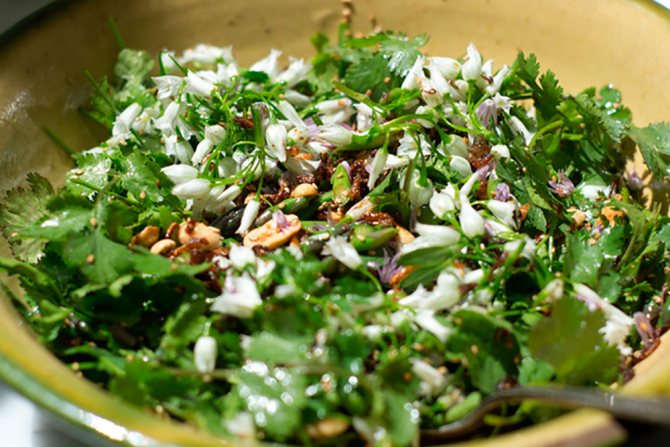

Fresh cilantro leaves are used in cooking, it is low in calories and helps to reduce excess weight
Cilantro gives food a special flavor. It is most commonly used in oriental cuisine. For example, in Uzbekistan, only seeds are consumed. Coriander recipes:
- Uzbek pilaf;
- barbecue;
- milk soups;
- vegetable salads;
- lula kebab;
- pies;
- refreshing drinks;
- sauces.
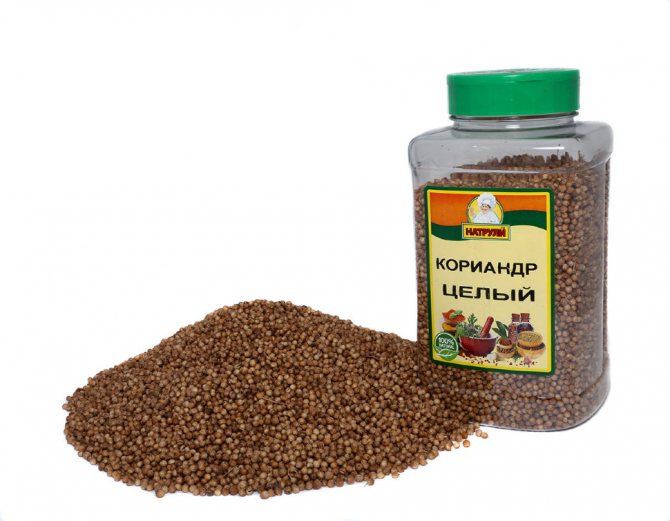

Coriander seeds can be purchased ready-made, but due to the specific taste, this seasoning is not used by all housewives.
Cilantro or coriander varieties
When choosing a variety, you must be guided by the ultimate goal. Vegetable varieties are preferred for collecting greens - they have more delicate leaves that are distinguished by high aromaticity. For coriander, choose varieties that produce the largest, highest quality seeds.
Popular cilantro vegetable varieties:
Cilantro avant-garde photo
Avant-garde is a compact densely leafy bush, greens have a thick spicy aroma, can be grown indoors. The first cut can be done after 45 days of growth.
Cilantro Caribe photo
Caribe is a late flowering variety. The leaves are heavily dissected, have a delicate taste, intense aroma.
Cilantro King of the Market
King of the Market - the variety ripens early. The amount of green mass is significant, the leaves are juicy, the taste is delicate.
Coriander Borodinsky photo
Borodinsky is a compact bush up to 70 cm high with an average ripening period. The greens have a mild taste and are good for salads. It is grown only outdoors. Harvesting can be started after 35 days of growth.
Cilantro Taiga photo
Taiga is a low bush with dense greenery. The variety ripens late: more than 45 days.
Picnic is an early ripening variety. The leaves are serrated, the taste is soft, the aroma is rich. Suitable for growing on a windowsill.
Features of application and preparation
The area of application of cilantro is quite extensive.
For women
The plant is of great benefit to the female body. In some cases, this spice plays a decisive role in the treatment of the disease. Common cases where cilantro can be used:
- pain during menstruation;
- depression;
- inflammatory processes;
- high cholesterol levels;
- anemia;
- kidney problems;
- deterioration of vision.
In addition, it helps with stomach ailments thanks to essential oils and vitamins. The daily intake can be found out after consultation with specialists. Excessive consumption can lead to menstrual irregularities and insomnia.
Cilantro is not recommended for use during pregnancy, since it can provoke the appearance of blood clots.
For men
The essential oils of this plant are considered to be powerful aphrodisiacs used in aromatherapy. The use of this seasoning in acceptable doses can enhance male potency and eliminate some pathologies of the reproductive system. The plant contains substances that have a beneficial effect on the nervous system, normalize sleep, and prevent the risks of depression and stress.
For kids
Cilantro is allowed to be added to food for children if it is used as a spice. Any methods of treatment based on this plant should be supervised by a pediatrician.
Broth, infusion, alcohol tincture
The extract of this plant is used for depression and nervous disorders. It is infused with vodka in the ratio of 1 part of seeds to 10 parts of alcohol. Coriander tincture can be prepared using various additives:
- horseradish;
- bread;
- malt;
- rosehip.
In China, cilantro broth is still used for longevity. The drink is also used as an expectorant and tonic for colds and coughs. Due to the healing effect, the decoction is used to get rid of sore throats. It is capable of sanitizing the mouth and throat. It is also used in the treatment of gastric disorders.
There are many traditional recipes for coriander. For example, this is a decoction of seeds for external use. Cooking method:
- 2 tbsp. tablespoons of crushed seeds pour 1.5 cups of boiling water;
- cook over low heat for half an hour;
- insist until it cools down;
- strain.
A decoction of seeds is used for external use in the healing of ulcers and wounds on the skin surface. It is also taken for diseases of the gallbladder and gastrointestinal tract.
In pharmacies, you can find medicinal teas containing the fruits of this plant. There are several types of this tea:
- choleretic;
- antihemorrhoid;
- laxative.
Choleretic tea recipe: immortelle flowers (4 g), watch leaves (3 g), coriander fruits (1 g) pour 2 cups of boiling water. The drink is taken half a glass 3 times a day 30 minutes before meals.
Essential oil
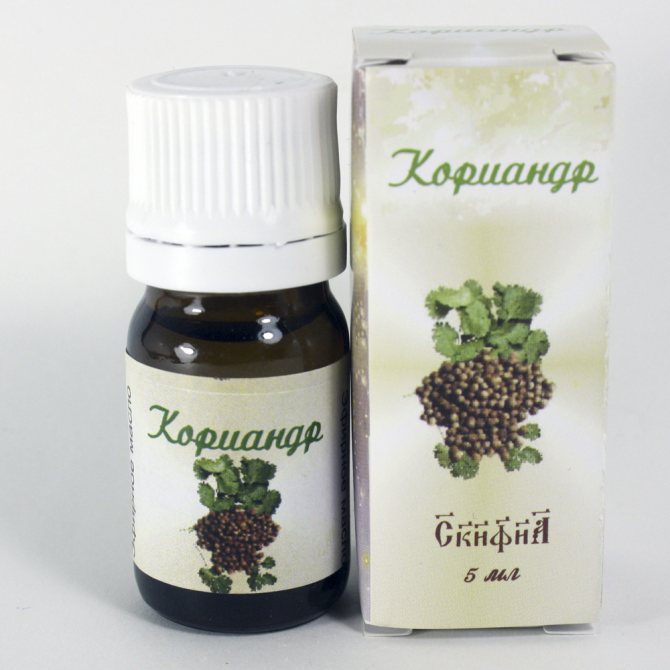

This oil has a beneficial effect on the human body both externally and internally.
The product is widely used in medicine to treat:
- arthritis;
- colds;
- indigestion;
- inflammation of the urinary tract in men;
- muscle pain;
- vessels;
- fungus;
- bad breath.
Ether is used in cosmetology as hair masks:
- nutritious;
- strengthening;
- enhancing growth.
In addition, it is used as an additive to face cream. As a result, fine wrinkles disappear. You can prepare a body cream based on the oil. It nourishes the skin with vitamins and relieves inflammation.
Coriander honey
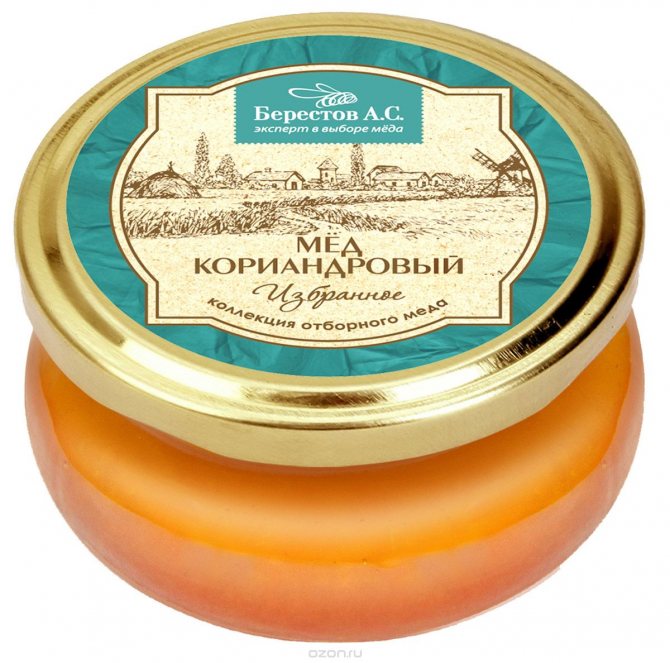

The honey of this plant belongs to the dark varieties, which are considered the richest in minerals.
Coriander honey is high in copper, manganese and iron. Crystallization occurs within 3 months, since there is a lot of glucose in the product.
Honey is always clear, ranging in color from amber to brown. Essential oils impart a medicinal flavor. Beneficial features:
- Increased appetite and improved digestion after taking even 1 tsp.
- Normalization of vision.
- Decrease in the amount of sugar in the body.
- Supplying the body with missing iron.
- Strengthening immunity, relieving chronic fatigue syndrome.
- Antibacterial effect during colds.
- Fight diarrhea and flatulence.
- Fast recovery of strength.
Honey is used as an antiseptic for washing wounds. Infusion with it helps to relieve inflammation in the throat and mouth. Already on the 3rd day of rinsing, there is an improvement. This beekeeping product is included in face and body masks. It makes the skin velvety, moisturizes it and fights fine wrinkles.
Store the product in a dark place at room temperature. It is not recommended to put it in the refrigerator, since the temperature there is too low.
Gastronomy and food industry
Coriander (ground and fresh) is a seasoning widely used in the culinary and food industries. Ways to use:
- Seeds are used to flavor stewed cabbage dishes (especially Savoy and red cabbage).
- The spice is suitable for legumes, lentils and beans. It is most often added to soups made from them.
- For the preparation of marinades, vegetables and fish (herring and sprat).
- The seeds are used for the preparation of the dessert, if they are candied.
- The spice is part of the curry seasoning. It takes 20-30% of the total volume.
- It is part of the seasoning khmeli-suneli, which is an irreplaceable part of some Georgian dishes (satsivi, lobio).
- It is an integral part of many sauces and adjika (satsebeli, dogwood, tkemali).
- The seeds are added to baked goods, cookies and gingerbread.
- It is used for sprinkling bread, loaves and rolls.
- It goes well with pumpkin and beetroot dishes.
- It is added in the production of sausages, canned vegetables and fish.
The plant does not lose its aroma even after drying. The seeds are best ground before use. Young leaves are used for preparing salads, as well as a seasoning for fish and meat dishes.
Outdoor care
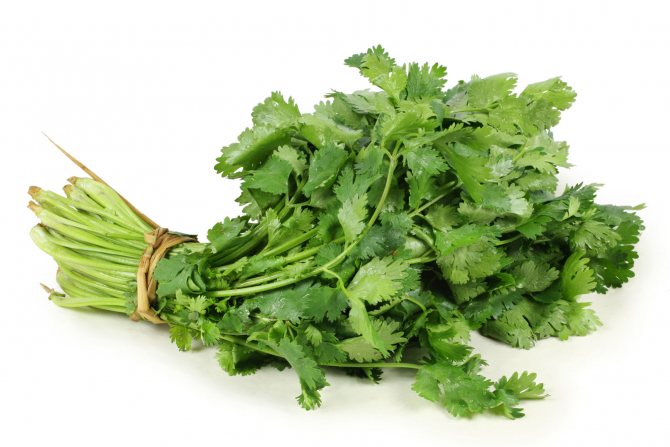

Bunch of cilantro (coriander)
Thyme - planting and care in the open field
Freshly grown plants need careful care. Weeds, if not removed in a timely manner, can destroy immature plantings. When removing weak plants, the ridge must be thinned out.
Note. Weak young shoots are good for human consumption.
When the coriander plant grows to the 5 cm mark, a nitrogen-based fertilizer should be applied to the soil. Mulching the soil will help keep the moisture level at the desired level, as well as slow down the growth of weeds.
The leading goal of events, how to plant and care for cilantro, and how to grow cilantro so that the harvest is abundant, is to stop the overgrowth of grass planting:
- Seedlings must be thinned regularly;
- The strongest shoots should be preserved;
- Irrigation is carried out as needed;
- Remove weeds in a timely manner;
- Loosen the soil periodically;
- Mulching is carried out by the root method;
- For fertilization, use potassium phosphate fertilizers.
Note. Before starting to plant coriander in a permanent place, it is necessary to apply mineral fertilizer to the soil.
How to water coriander
Regular irrigation will help you get a rich harvest of luscious greenery. A lack of moisture will lead to a deterioration in the quality of the process of forming a leaf rosette and the formation of excess arrowheads. 1 m2 planted with cilantro shoots requires 4 liters of water for irrigation. During the transition to the stage of enhanced germination, the volume of the liquid doubles.
Note. If cilantro planting and care in the open field is carried out in order to obtain a harvest of greenery, then it is necessary to regularly remove the peduncles.
Prevention of diseases and pests
Cilantro is susceptible to the occurrence of lesions by the following diseases:
- Ramulariasis;
- Powdery mildew.
It is possible to prevent the appearance of these diseases with careful adherence to agricultural techniques, avoiding waterlogging of the soil. If affected areas appear, they must be removed, and then treated with a fungicide.


Coriander essential oil
Note! During fungicidal treatment, it is not allowed to cut off the leafy part of the plant, especially for culinary purposes.
List of insect pests that pose a threat to coriander plantings:
- several varieties of bedbugs;
- seed-eaters;
- winter scoops;
- umbrella moth;
- wireworms.
Note. Pest prevention is carried out using insecticidal preparations.
Preparatory stage
Even before planting coriander, you need to decide on the choice of the site, prepare the beds and seeds. The development of plants and their productivity depends on whether this is done in time and how correctly.
Best predecessors
Cilantro will not grow well in all areas, it is important to pay attention to what crops have grown in this place previously. All legumes and cereals, root crops, cauliflower and early cabbage, onions, and green manure are considered good predecessors. Solanaceous, pumpkin, cruciferous, spicy and green crops are acceptable.
Cannot be planted after the umbrella: dill, parsley, fennel, watercress, carrots, celery, as well as turnips, medium and late cabbage. Onions, cucumbers, cabbage of all varieties, lettuce, root vegetables are planted next to the cilantro beds.
Site selection and soil preparation
You should choose a well-lit place in the garden for this plant, since the ripening time, the yield indicator and the concentration of essential oil in the seeds depend on this parameter. The beds should be located on a flat area or on a small hill, but not in a lowland. The soil is preferable medium in texture - loamy or sandy loam, light, neutral or slightly alkaline reaction (acidic will have to be limed).
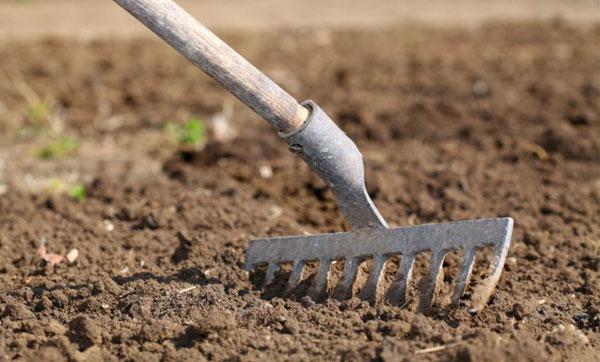

It is best to prepare the soil in the fall. First, it is cleaned of various plant debris, then it is dug onto a shovel bayonet and fertilizers are simultaneously applied (0.5 buckets per square meter and about 0.3 kg of ash). Sand is embedded in clay soil, and clay soil in sandy soil. Lumps do not break, they should freeze in winter, which will destroy pests in them. In the spring, add an additional 1 tbsp. l. urea and 30 g of superphosphate and potassium sulfate.
Recommended to read
Features of growing basil from seeds on a windowsill
Features of growing basil from seeds in the open field
Useful properties of cilantro (coriander) and contraindications
Features of growing dill on a windowsill from seeds
Seed preparation
The freshness of the seeding material of cilantro affects its germination, this is a feature of all plants of the Umbrella family: the fresher the seeds, the more friendly they germinate. Therefore, it is necessary to take coriander seeds for sowing only those that are not more than 2 years old, every year their germination decreases. You need to buy seeds only in shops for vegetable growers. Seeds sold in grocery stores are not suitable for sowing.
Another feature of cilantro seeds is that they sprout for a long time, therefore, to accelerate germination, they need to be soaked in water for 0.5 days. Soaking is optional when planting in early spring in wet soil. To make the cilantro rise faster, it is recommended to use growth stimulants or a 1 to 1 solution of aloe juice to soak the seeds.
Cooking use
The most common way to use cilantro in cooking is to add fresh herbs to salads. Not a single dish of Middle Eastern, Indian or Caucasian cuisine can do without this herb with a peculiar taste and smell. It is believed that the use of cilantro gives a unique flavor to food made from meat, rice, fish, it is added to various vegetable dishes and soups.
Many chefs and housewives prefer to put dried cilantro greens in their food, not fresh. It is dried, in the opinion of many, that it loses its inherent smell of bedbugs and acquires a light aroma and taste of anise. However, the most popular is the seed. The fruit has a warm, slightly nutty, very spicy aroma.
How to harvest
As the greenery grows, it is cut with a sharp knife at a height of 2-3 cm from the soil. The stems and leaves are suitable for consumption before flowering. After the plant has bloomed, the greens are rough and sparse.If during the growing season coriander was sown, then one plot is harvested up to three times.
To prepare cilantro, the greens are dried under a canopy, then chopped. Raw materials are stored in tightly closed glass containers so that the essential oil does not disappear. The shelf life of dry greens is 1 year.
You can prepare fresh cilantro. For this, the greens are washed, allowed to dry, cut and laid out in containers. The containers are placed in the freezer. The shelf life of cilantro is up to 2 years.
Coriander spices
Coriander is a common spice in Indian, Georgian and many other oriental cuisines. Coriander greens are included in recipes for pickles, baked goods, pickles and liqueurs. Due to its light taste, cilantro is ideally combined with other spices, for example, with basil, dill, chili, mint. The most popular combination of cilantro with cumin. Cilantro is also included in the Indian masala and curry mixture.


Properties of cilantro - harm and benefit
Useful properties of cilantro
The leaves and stems of cilantro contain rutin, carotene, vitamins, trace elements and essential oils, and the fruits of the plant contain steroid compounds, tannins, sucrose, fructose, glucose, polyphenols, fatty oils, pectin, alkaloids, starch and essential oil. The beneficial properties of cilantro are enhanced by seven organic acids contained in it: linoleic, oleic, isooleic, ascorbic, myristic, stearic and palmitic.
Due to its composition, cilantro has a diuretic, antiscorbutic, anthelmintic, analgesic and expectorant effect. It disinfects the gastrointestinal tract, increases appetite, improves intestinal motility, lowers blood pressure, helps to cope with insomnia, relieves nervous tension, edema, improves vision, enhances potency, stimulates kidney function, invigorates and tones.


Cilantro juice strengthens the gums and reduces bleeding, soothes toothaches, and disinfects the oral cavity in case of stomatitis. Greens remove harmful cholesterol from the body and have a beneficial effect on the work of the cardiovascular system. A few cilantro leaves reduce the effects of alcohol and relieve hangovers.
Beneficial features
The essential oil crop is used in various industries due to its beneficial characteristics. These include the following:
- cilantro enriches dishes with vitamins A and C;
- plant seeds contribute to the healing of abrasions, reduce pain, stabilize the digestion process and liver function, help in the treatment of hemorrhoids and eliminate constipation;
- frequent consumption of coriander strengthens the immune system, has antiseptic and anti-inflammatory effects;
- greens improves appetite, activates the process of excreting toxins from the body, improves intestinal motility, strengthens blood vessels and has a beneficial effect on blood composition;
- coriander lowers blood sugar levels, so it is recommended to include it in a regular diet for diabetes mellitus;
- essential oil culture helps to maintain your figure and fight overweight.


Which variety to choose
The choice of variety depends on what exactly the grower needs: greens or seeds. Of the varieties of coriander that give a lot of seeds, Borodinsky can be distinguished (the seeds of this particular variety are used in the production of the bread of the same name), Amber, Taiga, Venus, Avangard. The same varieties can be used for growing plants for greenery. Among the varieties of cilantro that give lush foliage, one can also note Debut, Stimul, Early, King of the Market, Alekseevsky, Kirovogradsky, Oktyabrsky, etc.
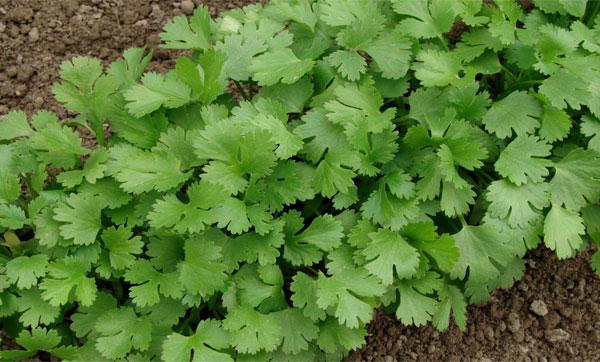

Coriander oil
Herbal oil is widely used in aromatherapy, medicine and other industries. The list of beneficial properties of organic coriander plant oil includes antibacterial, soothing, choleretic and warming properties.By adding coriander oil to the daily diet, you can prevent the development of diseases such as gastritis, flatulence, dyspepsia. Natural cilantro oil has been proven to promote good appetite, glandular secretion and active gastric acid production.
As a preventive measure, it is recommended to consume 1-3 drops of coriander oil mixed with honey every day.
External application of the oil product helps in the treatment of joint pain in rheumatism or arthritis, as well as in the relief of convulsive symptoms and muscle spasms. Due to its anti-infectious effect, coriander oil is used for skin diseases and inflammation. The soothing effect of the oil relieves nervousness and improves the condition in stressful situations. The use of the product is recommended for general fatigue and decreased immunity.
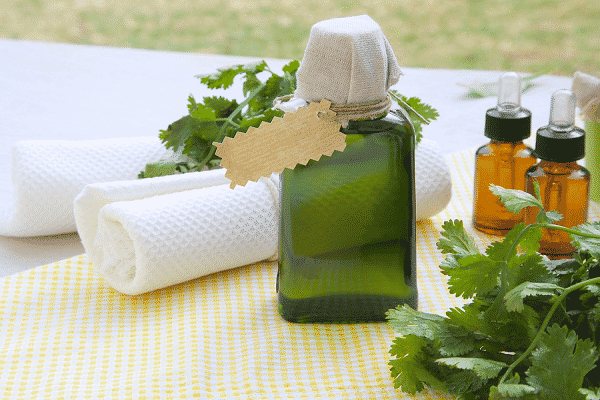

Appearance
The cilantro plant reaches a height of about 70 cm, has rounded stems branched from the base, erect fusiform root and pinnately dissected leaves. At the edges, coriander leaves can be serrated or three-lobed. During the flowering period, the plant is covered with small pale pink or white flowers, folded into umbrellas. Ripe coriander fruits are dark achenes about 50 mm long. The spherical coriander fruit of a brown-yellow color crumbles into two miniature spheres under pressure.
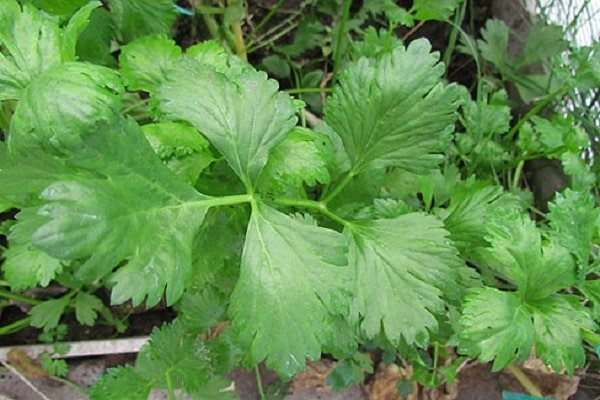

How to plant coriander seeds
For planting, ripe plant seeds are selected. They are brown in color, have a bright aroma and are easily removed from the umbrella inflorescences. Unripe seeds have a pungent unpleasant odor, which is compared to bed bugs. Seeds not older than two years of age have the maximum germination.
How to plant coriander seeds:
- Dry seeds are sown in moist soil. For 1 sq. meter leaves 2.5 gr. seeds.
- The sowing depth is between 1.5 and 2.5 cm.
To have a general idea of how to sow coriander, consider the basic seed planting schemes:
- in rows - the seeds are planted, maintaining a distance between the rows of at least 15 cm;
- scatter - randomly scatter seeds over the garden;
- in the holes - 2-3 seeds are planted in each hole at a distance of 10-15 centimeters from each other.
You will learn more about how to plant cilantro at home in the following video:
The benefits of cilantro greens
In addition to the nutritional function, restoration of the vitamin reserve, fresh herbs are:
- mild diuretic, eliminates morning swelling of the face and hands;
- greens are useful for frequent cystitis, pathologies of the bladder, urolithiasis;
- rinsing and bathing the oral cavity eliminate unpleasant odors, destroy harmful bacteria, relieve inflammation of the mucous membrane, strengthen the gums;
- used as a laxative for constipation and problems with intestinal peristalsis;
- decoction of stems rejuvenates the skin of the face, smoothes wrinkles, refreshes and tones.
Coriander fruits - where are they used and what is their value
It will surprise many that the main value of cilantro is far from its smell. In cooking, it has been used for a relatively short time, but in medicine it has been known for hundreds of years. The herb is medicinal and occupies one of the first places in Chinese traditional medicine. The cilantro fruit has a pain relieving effect, it quickly lowers the temperature and is an effective helper for your stomach. With the frequent use of this plant in food, the secretion of enzymes in the digestive tract is normalized, and the food is absorbed as best as possible in the intestines.
Chisinau reduces high blood pressure and increases blood clotting, due to which it is recommended for many patients around the world as a preventive medicine. On its basis, more than 250 medicines have been made, which are intended for the treatment of genitourinary diseases. For burns, coriander juice is used, which not only promotes skin renewal, but also soothes pain.
Cilantro juice is versatile.It helps with coughing, is recommended for use with infectious sore throat and conjunctivitis. Has a very strong anti-inflammatory effect. Coriander (cilantro) normalizes the intestinal and stomach microflora, it is recommended for patients with gastritis and for the prevention of ulcers.
This article discusses how to grow coriander. You will learn how and when to plant coriander outdoors and how to choose a site for planting spices. Following our advice, you will learn how to properly care for the plant, harvest and store the crop. We will show you how to water, feed and thin out the sprouts.
Coriander is massively grown in the south of the European part of Russia, in the North Caucasus and in Ukraine. Sometimes cilantro is grown at the latitude of Moscow and even in Yakutia.
The appearance of coriander outdoors
Planting coriander is quite simple, does not require complex manipulations and special knowledge, so even a novice vegetable grower can handle it. Coriander is planted in the garden and at home.
Depending on the purpose, a plant variety is selected. There are varieties that do not bloom for a long time and give a lot of greenery, they are called vegetables. If the goal is seeds, then you should choose varieties that bloom and bear fruit quickly. Their greens are thinning, the stems are coarse. These varieties are grown to produce essential oils.
Before planting coriander, decide on the variety. Let's consider the most common ones:
- Amber
- an essential oil-bearing spicy variety with a characteristic strong aroma, late shooting and an abundance of greenery. Occupies about 90% of all cultivated areas. It rises on 12-15 days. Greens ripen in 30-35 days. - Borodino
- early ripening variety. Greens ripen by 30 days, seeds - 50 days. - Taiga
- late-ripening variety. The greens are brightly colored and dense. Ripens by 35-45 days after germination. - Vanguard
- a low-growing variety with a strong aroma. Mid-season variety, ripens by 40 days. - Debut
- late-ripening variety with a characteristic spicy aroma and delicate taste. Ripens by 35-45 days. - Stimulus
- mid-season vegetable variety. The rosette of leaves reaches a weight of 45 grams. Sown after vegetable crops in the soil with organic fertilizers. Greens ripen for 40-45 days.
All varieties of coriander prefer light, fertile soil, which must be fertilized before planting. Consider the features of growing coriander in the open field.
Herb-cilantro - care for the first month
Watering is carried out constantly - this is the basic rule of every gardener who has taken up the cultivation of the seed hamem (another popular name for cilantro). In terms of the amount of necessary moisture, it is inferior only to rice. The plant must constantly feed in order to maintain its herbaceous shape for as long as possible. Watering can be carried out daily at 5-8 liters per 1 square meter - this will be quite enough.
Cilantro requires long daylight hours, therefore, when it is reduced, it slows down growth. Thus, planting in July or August can be much more beneficial for gardeners who need a lot of green mass and do not care about full maturation of the grass. Peduncles will begin to form only after 1.5-2 months, especially if abundant watering is provided. In all other respects, growing coriander is similar to caring for dill or parsley.
Growing culture care rules
Water your green pets promptly and regularly. It is enough to do this only twice a week, the main thing is to observe the rhythm, pouring out on each square. meter of 5 liters of water. Watering is especially important for the sprouts during the growing season. Watering is halved in volume as soon as the fruits ripen.
But what if you can't water the cilantro so regularly? For example, she may not be at home, but at a summer cottage. In this case, you need to mulch the soil so that the moisture lingers in it longer.
Once again we emphasize the importance of full illumination of the sown area.
Spicy fragrant greens are obtained only with good access to sunlight.
Although it can be more or less replaced by daylight - from lugs, which is especially important if the coriander grows at home.
Coriander oil
Coriander essential oil is obtained by steam distillation of seeds. It is an amber liquid with a specific taste and smell, which has a wide range of actions, including:
- antiseptic;
- pain reliever;
- choleretic;
- antihemorrhoid;
- hemostatic;
- wound healing;
- sedative.
The oil of the plant is used in aroma lamps, for massage, as part of ointments for grinding. With its mild warming effect, it can relieve joint and rheumatic pains. The muscle relaxant effect of the remedy will help with muscle pain after strenuous workouts, sprains and bruises. Coriander essential oil is good for treating acne and youthful acne. The antiviral effect of the substance can help prevent the spread of influenza during an epidemic, since it has excellent antiseptic properties.
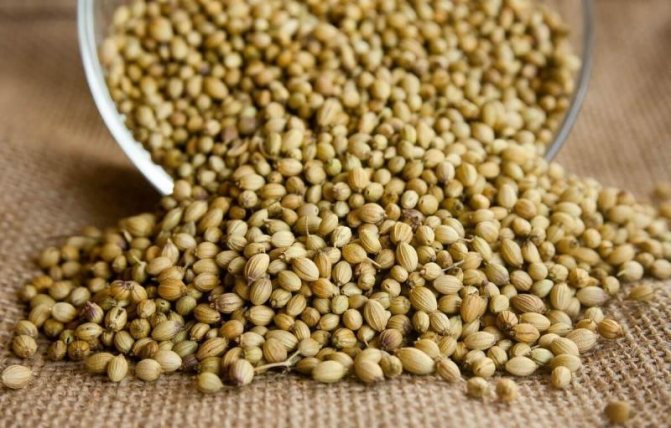

Possible problems with growing coriander
Coriander is a persistent culture. He has few pests, but in an unfavorable set of circumstances, you should be ready to fight them. The main thing is to periodically pay attention to the appearance of the plant. This will allow you to see the problem in a timely manner.
The main weapon in the fight against all coriander ailments is prevention and adherence to agrotechnical rules.
Table: coriander pests and control measures
| Pest | Signs of defeat | Harm | Control measures |
| Coriander seed |
| Damages the inside of the seed. As a result, it loses germination, weight |
|
| Aphid | Small green, black or gray insects on cilantro leaves, as well as traces of their vital activity - sticky sticky plaque | It feeds on plant sap, weakens it, can lead to death |
|
| Striped bug, or line bugs | A large insect about 1 cm long with a red scutellum and longitudinal black stripes on the stems and leaves of coriander | It feeds on milk from immature seeds, piercing the shell and sucking out the insides. Damaged seeds die off before ripening |
|
| Umbrella moth |
| Caterpillars damage the leaves, inflorescences and fruits of the plant, entwine them with cobwebs |
|
Cilantro is an unpretentious plant and, with proper care, is resistant to diseases, however, sometimes, under unfavorable growing conditions, it is still affected by ramulariasis, root rot. Fruits may turn black. If you are careful, you can always notice a plant disease in time and eliminate it.
Table: the main diseases of coriander and methods of dealing with them
| Disease | Signs of defeat | Control methods |
| Ramulariasis | Brown spots with a dark crimson halo on leaf blades. Gradually, they brighten in the center, merge and cause the leaf to dry out. Affected plants are stunted. Wet and cold weather favors disease development |
|
| Root rot | Yellowing and drying of leaves, stems, decay of roots. At the root collar, you can see a white, pinkish or reddish mycelium. |
|
| Bacterial blackening of fruits | A small dimple first forms on the fruit. From her, blackness extends to the entire fruit (it darkens and dries up), to the leaves and stem of the plant. The onset of the disease is facilitated by high humidity and air temperature within +20 degrees |
|
Photo gallery: the main pests and diseases of coriander


The female umbrella moth lays about 200 eggs on the underside of the coriander leaf stalks
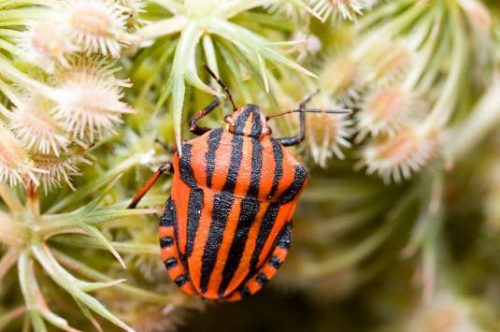

The striped bug is poisonous and warns all birds and insects about it in advance using its color


The striped bug is widespread in the south and in central Russia, in Siberia, in the Caucasus
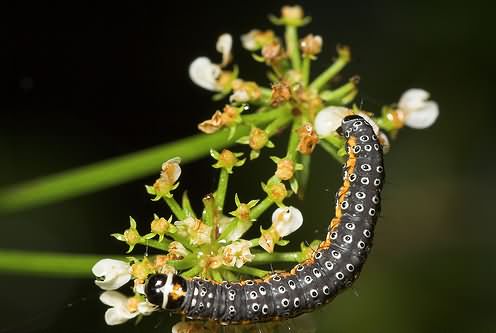

The coriander inflorescence damaged by the caterpillar of the umbrella moth darkens, dries up, the top of the plant seems to be scorched by fire
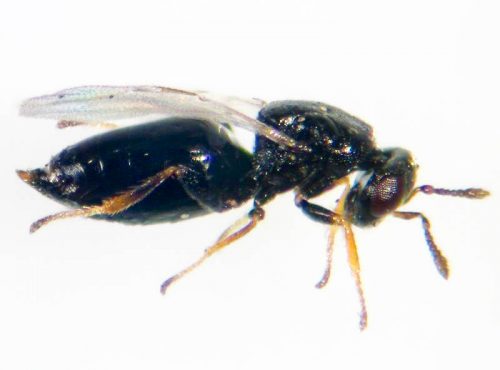

Coriander seed (or coriander wasp) damages coriander, caraway seeds, fennel, anise and some other plants of the umbrella family


Aphids multiply quickly, so the coriander is literally covered in insects.


Ramullariosis affects the aerial organs of coriander (cotyledonous, rosette and stem leaves, stems, buds, umbrellas, flowers, ovaries and fruits) during the entire growing season


Coriander root rot leads to yellowing and drying of leaves, stems, root rot
In addition to diseases and pests, coriander has an agrotechnical problem - flowering too quickly. It does not allow the full use of fresh herbs and deprives the gardener of the nutrients that the plant contains. To prevent this from happening, it is important to know the possible causes of the phenomenon:
- wrong (unsuitable for a particular region) variety choice;
- growing in the shade;
- thickening of landings;


In thickened plantings, cilantro blooms too quickly - lack of moisture;
- poor air permeability of the soil.
To get enough fragrant greens, you need:
- choose the right variety for growing;
- plant coriander in an area with sufficient lighting;
- follow the rules for watering and loosening the soil;
- to thin out crops in a timely manner;
- for home cultivation - provide additional lighting.
Varieties and types of coriander
Before you start planting coriander on your site, you need to decide for what purpose you plan to grow the plant, and, depending on this, choose the right variety. When choosing, you should pay attention to the ripening time, the yield of greens and fruits, aromatic qualities, the saturation of the color of leaves and seeds. 13 varieties of this plant are included in the State Register of Breeding Achievements approved for use on the territory of the Russian Federation. Three of them (Medun, Mius and Early) are recommended for growing in the North Caucasus region, the rest have no restrictions on the growing area.
Table: coriander varieties included in the State Register of Breeding Achievements
| Variety name | Vegetation period, days | Description | Seed yield, g / m2 | Features of the |
| Chord | 109 |
| about 100 |
|
| Alekseevsky 190 | 89–91 |
| about 150 |
|
| Alekseevsky 413 | from 66 |
| from 120 |
|
| Aroma | 109 |
| from 60 |
|
| Medun | N / a | Compact plant with an erect stem up to 115 cm high | about 220 |
|
| Mius | N / a |
| from 110 | Drought tolerant |
| Nectar | 30–40 | Branched bush up to 90 cm | N / a |
|
| Early | 30–50 | A highly branched plant about half a meter high with large dark green leaves and a persistent, strong, spicy aroma | about 150 |
|
| Light coloured | 100–110 |
| from 100 | Weakly affected by ramularia |
| Strongman | 251 |
| from 220 |
|
| Eva | 35–45 | Semi-closed bush about 60 cm high with a stem of medium thickness | about 140 |
|
| Yialos | 107 |
| from 130 |
|
| Amber | 40–45 | Compact bush, about 50 cm high | about 150 |
|
Photo gallery: varieties of coriander of domestic selection
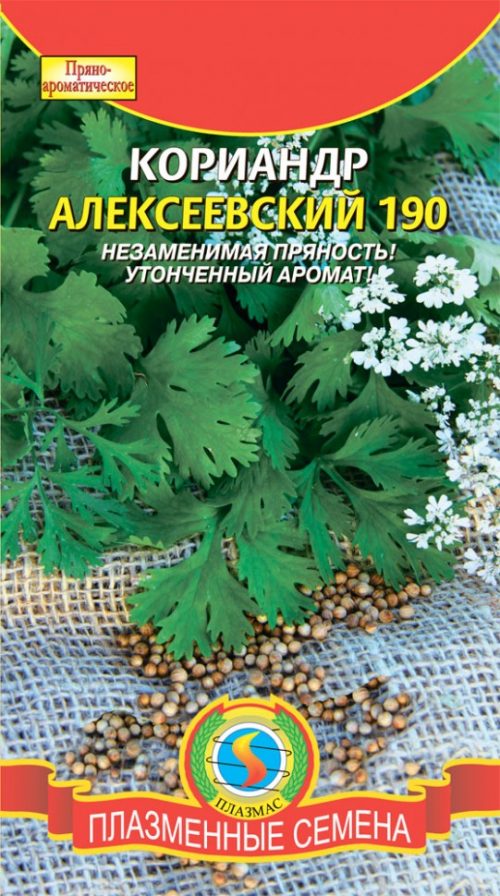

Coriander Alekseevsky 190 is grown directly to obtain a harvest of mature seeds
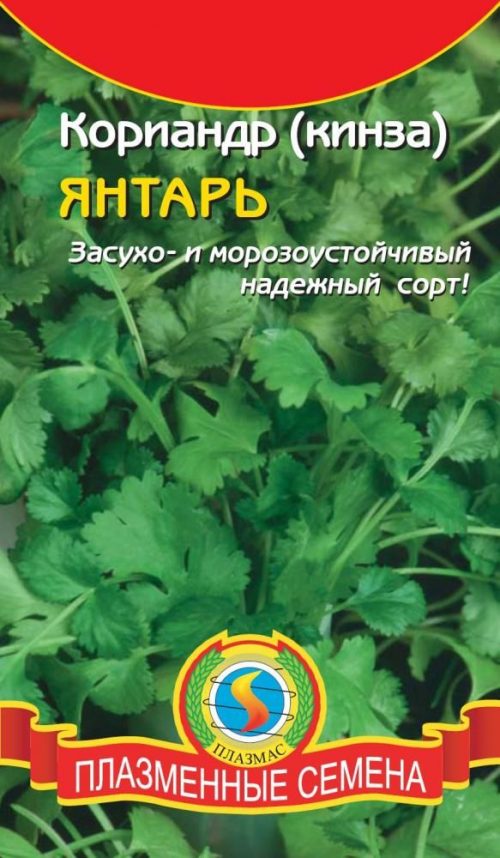

Amber coriander is distinguished by good leafiness, slow shooting, high aroma
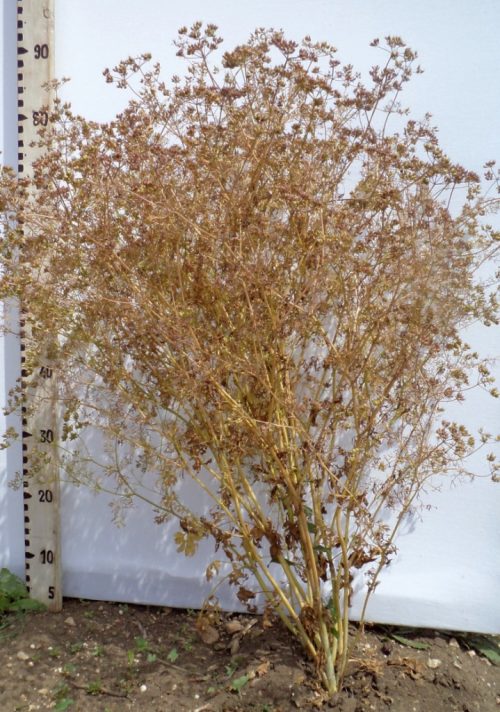

The main qualities of the Medun variety are resistance to ramulariasis, increased winter hardiness, the ability to grow during winter and spring sowing periods
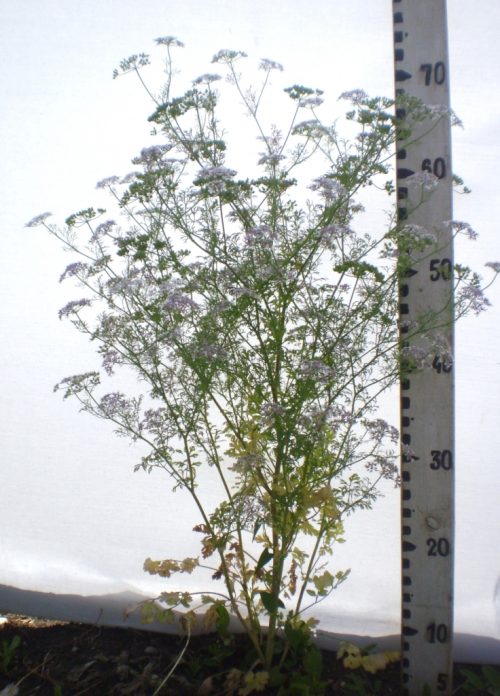

Mius coriander - a variety of spring sowing period


Nectar is a variety suitable for winter and spring sowing periods
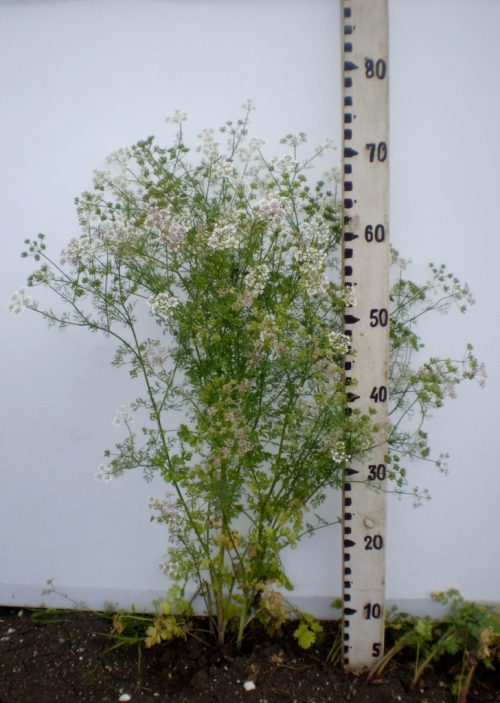

Early coriander is a fast-growing leafy variety.
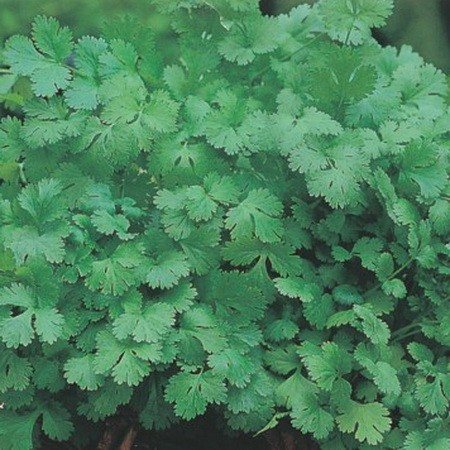

Coriander Light is a mid-season variety with juicy leaves of increased aroma
Diseases and pests of coriander
Diseases
If you take care of the coriander incorrectly or do not follow the agrotechnical rules of the culture, the bushes can be affected by rust, ramularia or powdery mildew.
Ramulariasis
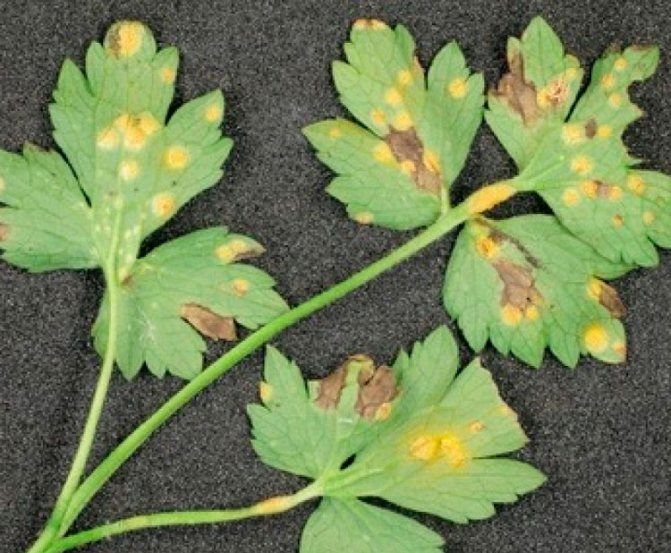

Ramulariasis is a fungal disease that actively develops in high humidity, if it is very cold in the summer and abundant dew falls in the morning. This disease can destroy coriander bushes. On the surface of the leaf plates, specks of brown color are formed; over time, a pale gray bloom appears on them. Outwardly, the bush looks like a burnt one, and dies rather quickly. In order to prevent the seed, before sowing, it is necessary to pickle with a solution of Fitosporin-M, while in the area where cilantro grew last year, it cannot be sown this season.
Rust


Another fungal disease is rust, it is very common and can greatly harm this crop. In the affected bushes, pustules of an auburn color form on the surface of the leaf plates, they tear over time, and spores of the fungus spill out of them, carried by insects or the wind. To prevent the bushes from getting sick with rust, it is necessary to take the same preventive measures as in the fight against ramulariasis.
Powdery mildew


Powdery mildew is also a fungal disease. A whitish bloom forms on the aerial part of the affected plant. Over time, this plaque becomes denser and changes its color to brown. The disease develops most actively in dry and sultry weather with sharp changes in temperature and humidity. A large amount of nitrogen in the soil can also contribute to the development of the disease. All diseased bushes must be removed from the soil as soon as possible and destroyed. To get rid of such a disease, if you wish, you can resort to folk remedies that are distinguished by their non-toxicity: the foliage should be treated with a solution of soda ash or fresh mullein, yogurt or infusion of fermented weeds.
Harmful insects
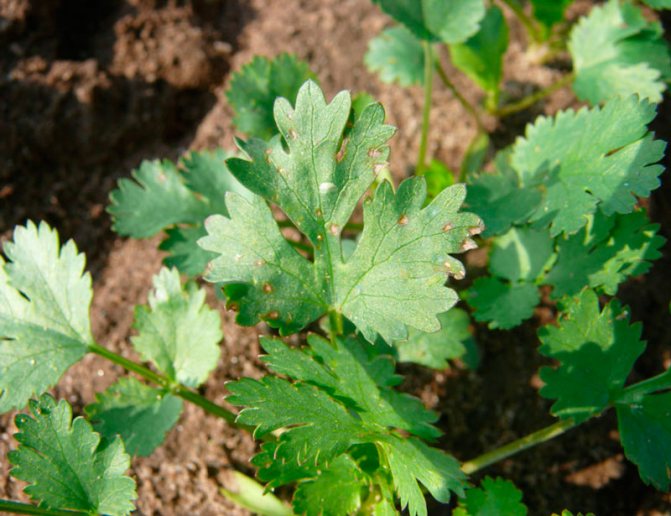

On cilantro, striped and umbrella bugs, seed eaters, as well as caterpillars of the winter scoop can settle.
Since experts do not recommend spraying the bushes with insecticides, in order to prevent the appearance of a seed eater on the bushes, the seed must be etched before sowing. In the autumn, it is imperative to clear the site of all plant residues, and the soil at this time will need a deep digging.
If bugs or scoop caterpillars appear on the bushes, they will need to be collected by hand. If a lot of cilantro is grown, then the bushes can be treated with a solution of wood ash or mustard, and an infusion of onion husks can also be used.
Care
No special care is required to ripen cilantro. It is enough to follow a few standard rules. First of all, abundant watering is important for the plant. The maximum need for watering occurs at the beginning of the growing season. During seed ripening and in the budding phase, moderate watering is required. Under the condition of long rains, the plants can not be watered, as excess moisture leads to the formation of rot.
In the first month of growing coriander, after each watering, gently loosen the topsoil to improve aeration of the roots. Otherwise, the plants will significantly regress in growth. To build up dense vegetation, seedlings must be dived or thinned out at the stage of growth of the second leaf.


How to care
For a good harvest, create ideal conditions for the coriander, otherwise it will prematurely bloom and stunt the growth of lush foliage.
Watering
Cilantro loves moist soil.For the first few weeks of growth, moisten the soil with a spray bottle. Then water gently at the root about once a week. When watering, make sure no water gets on the leaves.
Never let cilantro plants dry out, they are very sensitive and stress like this will have a negative effect on growth.
Lighting
Kinza will need at least six hours a day of sunshine. If the amount is insufficient, you need to use additional illumination with fluorescent or special phytolamps.
Fertilizer
Feeding coriander with a universal liquid fertilizer once a month will increase the splendor of the greenery, but you should not get carried away with this.
Pests and diseases
Coriander greens can be attacked by aphids and spider mites. Use organic control agents against them by following the instructions on the package.
The most common disease that can kill this herb is powdery mildew. It can develop in a humid, warm environment.
To prevent powdery mildew, ensure good air circulation and avoid shallow watering. Wet leaves also promote the growth of many other fungal infections.
A little about cilantro
Like the famous spicy carrot, cilantro (coriander) has become famous thanks to Korean gardeners and chefs. In Korea, they say that weed can prolong life. And this fact has been known for more than five thousand years! It is worth listening. Moreover, growing it is not a difficult process at all, and you can grow it, both outdoors in the garden in the country, and at home.
Possessing a rather pleasant aroma, the heroine of our article is an annual plant belonging to the Umbrella. Not only seeds are fragrant, but also greens, therefore they are also used, both dried and fresh. Outwardly, cilantro is also pretty, therefore it may well serve as a simple decoration for your windowsill.
Video about the benefits of cilantro
The technology for working with cilantro divides the cultivation into two stages. Before the seeds ripen, the grass is grown for the sake of greens (actually, cilantro). And when the seeds are ripe, they focus on getting coriander.
Success secrets
Cilantro prefers open, sunny areas, but thrives well in light partial shade. Indoor growing may require backlighting.
An important part of caring for this plant is weed control. Also Coriander seed is moisture-loving. Young seedlings need moderate watering. During the period of active growth of green mass, they are increased, and at the end of flowering they are reduced to a minimum.
For irrigation, you must use water warmed up under the sun. Mulching will reduce the amount of moisture.
After each watering, the soil should be loosened to prevent crusting.
Harvesting and storage
The coriander greens need to be cut when the bush has not yet begun to actively bloom. This can be determined by the characteristic decrease in the growth rate of greenery, on average, the height of the plant by this time reaches 18-22 cm, depending on the variety. It is advisable to cut greens in the early morning, use only a well-sharpened tool.


After harvesting, the shoots should be well rinsed with running water, collected in equal bunches and put in a dry and dark place. Store crushed dried cilantro preferably in a sealed glass container. Greens can also be used for freezing, but the beneficial properties and aroma of the spice are lost.
Photos of plants
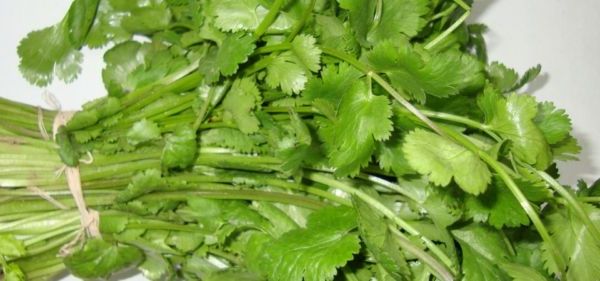



Coriander: greens, seeds and ground


Cilantro greens

